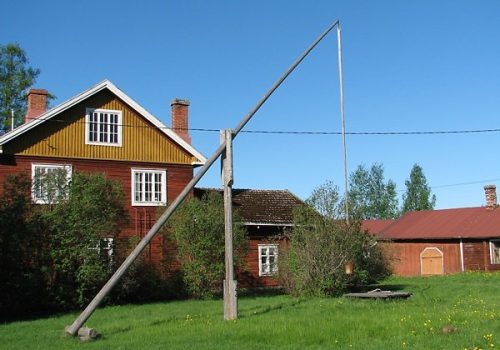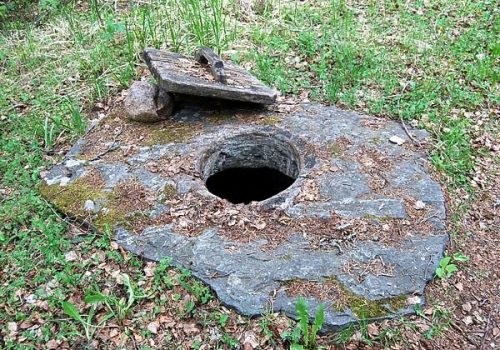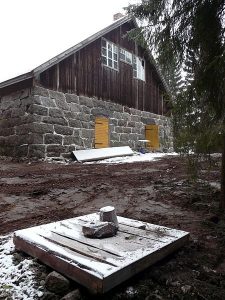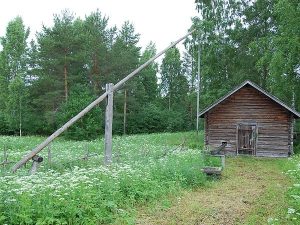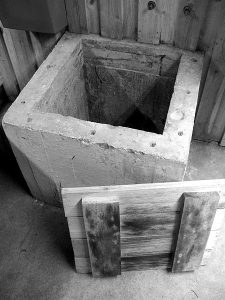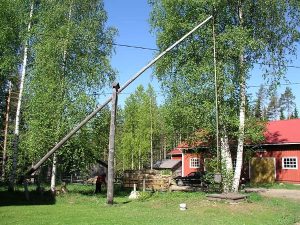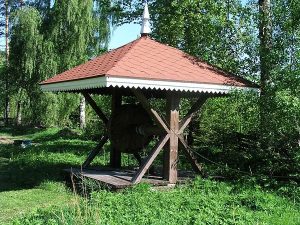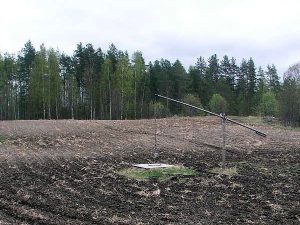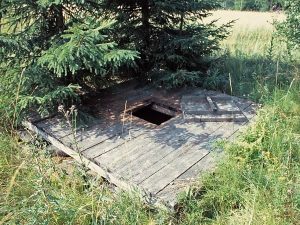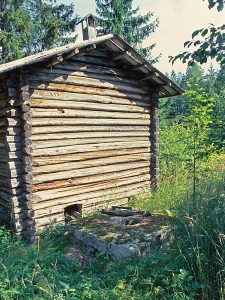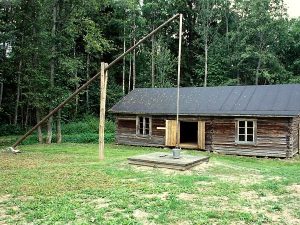The Well
Next to the sauna or in a concrete dugout.
Stone-ringed or concrete-capped.
With a wooden crane or a cast iron pump.
Introducing the wells of the Southern Savo local museums.
Karhulahti Local History Museum
Joroinen
When the site became a museum, the well behind the main building was fitted with an internal lid to keep moles from falling in. The cap is made of 5-centimeter-wide planks on top of a single timber beam. The cap measures 153 x 158 cm, and the well’s mouth measures 50 x 60 cm. Two additional beams have been affixed to the top of the well crane’s vertical pole (known as the ”tantari”) to make a fork for the horizontal pole. There are likewise two beams supporting the tantari at the bottom.
Harjukoski Watermill
Mikkeli
This well near the smoke sauna was partially bored into bedrock and partially built from natural stone. It has a depth of about 1.8 m and a diameter of about 1 m. The cap is a single flat piece of natural stone, measuring roughly 160 x 125 cm. The cap’s origin may be related to the mill itself, as the builders had to break away some of the local rock to clear space for the building. The material for the main building’s foundation, finished in 1916, was also taken from the same rock formation. The cap is roughly 20 cm thick, and the 40-cm-diameter hole was made with hand tools and covered with a small plank lid. Water was brought up from the well using a bucket on a pole.
Iso-Pappila Museum Site
Mäntyharju
This well in the yard in front of the woodshed is fully covered by a lid measuring 198 x 195 cm, constructed from 10 x 5 cm planks. The walls of the wellhead are made of 7.5 x 15 cm planks, stacked two and a half layers high. The planks are notched halfway through in the corners. There is a natural stone foundation under the wellhead.
Iso-Pappila Museum Site
Mäntyharju
In the summer of 2011, this barn well was discovered near the stone cowhouse. It is a roughly 4.8 m deep stone-ringed well, with a zinced water pipe leading to the cowhouse. Since the lid had rotten away, it was fitted with a new holeless lid made of planks and timber, as part of a broader regional renovation initiative.
Local Museum
Punkaharju
This well next to the smoke sauna is ringed with natural stone and measures around 3 m deep and 1 m wide. The 129 x 135 cm lid is made of 10 x 5 cm planks, with a 54 x 64 cm hole. A single layer of round timber beams forms the walls of the wellhead. After the water had been brought up with the crane, it was poured into the sauna along the wooden gutter.
Liehtalanniemi Museum Farm
Puumala
This well by the kota hut measures around 1.3 – 1.4 m deep counting only the borehole, or around 1.8 m including the lid. It is ringed with natural stone and ranges from around 80 to 90 cm in internal diameter. The water level varies between 70 to 100 cm. Sometime after the early 1980’s, a concrete ring was added on top of the stone ring, with the half-beam lid lying on top of that. The well has a crane for bringing up water – back in the1940’s they used a wooden bucket on the end of a pole.
Pattoi Heritage House
Juva
This natural-stone shaft well by the woodshed is about eight metres deep, with a mouth roughly 2.1 m in diameter. The shaft broadens as it goes, becoming pear-shaped towards the bottom. The well was built in 1949 – 1950 by Matti, Mikko and Mauno Hämäläinen. The men were paid 5000 Finnish marks and five hectolitres of rye for their work. They had to dig the hole and lay the stone ring while the ground was frozen, to keep the water from muddying and the shaft from collapsing. In the 1950’s water was brought up with a well crane, which was then replaced with a wooden pump, now itself replaced with a hand-cranked cast iron Nira pump. The brand name derives from the name of Niilo Ranni, the founder of the Vammalan Konepaja machine works, which started manufacturing well pumps in 1934.
Machine Gun Post and 20-Bunk Dugout Number 4
Puumala
This reinforced concrete dugout was built in 1941 as part of the Salpalinja defensive line, a line of fortifications that stretches along the Finnish border from the Gulf of Finland north to Savukoski, and from there all the way to the Arctic Ocean. Regulations demanded each dugout to have either a well or a 300-to-500-litre water storage tank – this particular dugout had a well right in its living space. Depending on the water level, and thus the well’s depth, the dugout wells were either made of stacked cement rings or bored into the bedrock. There was to be at least a metre of water at the bottom. Hand pumps made it possible to transport the water through pipes into the living space’s wash basin, or into the machine gun nest to serve as coolant. A spare bucket was also kept nearby for emergencies. The wooden lid has been saturated with oil varnish.
Local History Museum
Heinävesi
This stone-ringed well, about 7.3 m deep, lies near the newer building of the regional museum (a former granary). At a later point in time a concrete wellhead was added on top of the pre-existing well, along with a half-metre radius of concrete laid around it. The well is equipped with a Nira 4 brand cast iron pump. The brand name derives from the name of Niilo Ranni, the founder of the Vammalan Konepaja machine works, which started manufacturing well pumps in 1934. The old lid was made of planks (12.5 x 5 cm) and, despite being varnished, had decayed so badly that it was replaced in the summer of 2011 with a new octagonal plank lid.
Valkeamäki Local History Museum of Virtasalmi
Pieksämäki
There are two wells in the schoolyard of the old Valkeamäki public school, next to the museum. The one off the end of the school building is a concrete-ringed well from the 1960’s. According to a water dowser, the water there should have been five metres deep, but in reality they had to dig for ten metres. A crane was added to the well at the turn of the millennium, when the site became a museum. The borehole was shortened by dropping in an 80 cm bottom ring, which left the well with a functional depth of 3.2 m or so. The wellhead extends roughly 21 cm off the ground, and is 141 x 141 cm around. It is made of 7.5 cm thick planks, with a hole measuring roughly 52 x 49 cm.
Valkeamäki Local History Museum of Virtasalmi
Pieksämäki
The other well lies across the schoolyard and is stone-ringed, with a roof over it. The rectangular pyramid roof is felted and has an ornamental spire in the middle. The eaves are saw-toothed. Suspended between the roof’s vertical support beams is a round log with a large, solid-wood flywheel on it. There are knobs along the wheel’s edges on both faces, making it easier to spin it and move the water bucket up and down. The plank lid measures roughly 272 x 275 cm; the roof is slightly larger. Beneath the wooden lid there is a 10 cm thick concrete lid, with a hole measuring 61 x 53 cm.
Peasant Museum of Pien-Toijola
Ristiina
The old stone-ringed well of a smoke sauna still remains in the middle of what is now a field. A new lid was built at the turn of the 80’s and again in 2007, which is also when the crane was added. The blueprints give the lid’s measurements in centimetres, except for the individual planks, which are measured in inches.
Pitkäpelto Local History House
Kangasniemi
The Local History House has two wells in the traditional places: one for the cattle and one for the sauna. The stockyard well is laden from natural stone and measures roughly three metres deep and 1.8 metres wide. Back when there were still cattle at the farm, the water was brought up with a hand pump and poured along a plank gutter to a wooden drinking trough on the other side of the fence. The water was not used by people, as the well was too close to the stockyard. The plank lid is 245 x 250 cm around, with a 58 x 55 cm hole.
Pitkäpelto Local History House
Kangasniemi
The stone-ringed well near the smoke sauna used to have a crane for bringing up water. It is roughly 2.6 m deep and 80 cm wide. There are two holes in the sauna’s wall, with wooden gutters allowing the water to be poured inside. The well’s squarish capstone (around 155 x 160 cm) was brought in from the burnt-down school of Unnukkala, in Kangasniemi. The stone’s width varies between 5 and 35 cm, and the round hole in the middle is around 40 cm in diameter. 13 cm off to both sides of the main hole there are additional through-holes. There are also drill holes in the sides of the stone, indicating it was quarried from a cliff face.
Vanha-Rantala House Museum
Pertunmaa
The museum’s well is laden from natural stone and measures roughly 4.5 m deep and 1.9
m wide. The well is right in front of the “tolla”, or household storage building. The plank
lid is 207 x 220 cm around, with a hole 52 x 50 cm around. The ground around the well
has been worked to slope away from it. The lid and crane were both renovated in 2006.
Published Jul 5, 2024 │ Text by Jorma Hytönen/Riihisaari – Savonlinna museum │ Translation by Pekka Pirinen/Riihisaari – Savonlinna museum
Photos Jorma Hytönen/ Riihisaari – Savonlinna museum │ Kati Arola/Municipality of Joroinen │ Hanna Kemppainen/The Centres for Economic Development, Transport and the Environment of South Savo │Brita Suokas/Municipality of Juva
Photographed 2008–2011
Last modified: 11 Jul 2025
